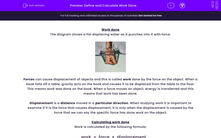Work done
The diagram shows a fist displacing water as it punches into it with force.

Forces can cause displacement of objects and this is called work done by the force on the object. When a book falls off a table, gravity acts on the book and causes it to be displaced from the table to the floor. This means work was done on the book. When a force moves an object, energy is transferred and this means that work has been done.
Displacement is a distance moved in a particular direction. When studying work it is important to examine if it is the force that causes displacement. It is only when the displacement is caused by the force that we can say the specific force has done work on the object.
Calculating work done
Work is calculated by the following formula:
work = force × displacement
When the unit of the force is Newtons (N) and displacement is measured in metres (m), the unit of work is Newton metres.
1 Newton metre is equal to 1 joule (J). This is because work done equals energy transferred.
Simple machines
In ancient times, people invented simple machines that helped them to overcome resistive forces so that they were able to do work that seemed impossible, like building the pyramids in Egypt.

Simple machines work in the following ways:
Transfer a force from one place to another
Change the direction of a force
Increase the magnitude of a force
Increase the displacement the force causes
Change the speed of the force
Examples of simple machines are the lever, the wheel and axle, the pulley, the inclined plane, the wedge and the screw.
A machine produces a mechanical advantage when the force applied by the person using it (input force) is smaller than the force applied to the task (output force).

Let's try some questions now.








